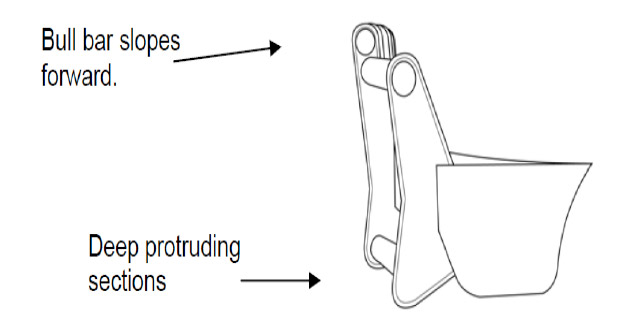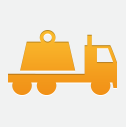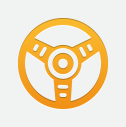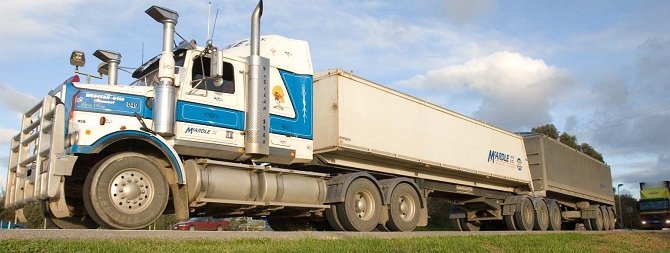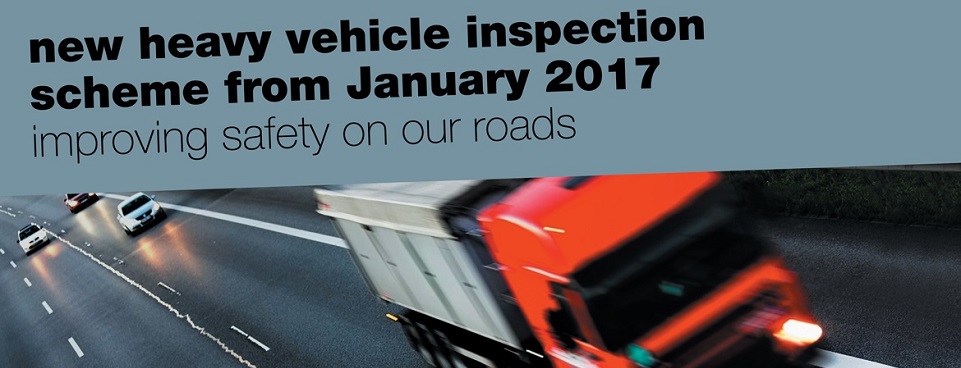Safer vehicles
Bull bars


South Australian Bull Bar Standard
All newly manufactured light vehicles with a bull bar fitted must comply with the Australian Standard for bull bars. This means that all bull bars fitted to vehicles with a gross vehicle mass of less than 3.5 tonnes must conform to the shape of the vehicle. Over time, this will eliminate aggressive upright or forward facing bull bars from being fitted in South Australia.
The Standard does not apply to vehicles manufactured before 1 July 2013.
Further information on the South Australian bull bar Standard is available from sa.gov.au.
Supporting research
Research conducted by the Centre for Automotive Safety Research (CASR) at the University of Adelaide has confirmed that South Australia's implementation of the State bull bar standard significantly benefits the community by improving pedestrian safety.
The report from CASR used both laboratory results and computer simulations to identify a major difference between pedestrian impacts with a compliant and non-compliant bull bar.
Results demonstrated that a bull bar which meets the South Australian standard results in lower pedestrian head impact speeds with the vehicle, reducing the severity of the impact and resulting in a reduction to the risk of a serious head injury by well over 50%.
A copy of the report is available from the CASR website: casr.adelaide.edu.au
Bull bars and road safety
When a poorly designed bull bar is fitted to a vehicle it can be dangerous to vulnerable road users such as pedestrians and cyclists and can adversely affect the safety of the vehicle too. A bull bar designed and certified to meet the Australian Standard ensures the operation of critical safety features such as driver and passenger airbags are not affected. A bull bar that complies with the Australian Standard will also minimise the risk of injury in the event of a collision with another road user.
Rural areas
In rural areas, bull bars are often fitted to help protect a car in a crash with an animal (eg. a kangaroo). Bull bars also help provide additional frontal protection from scrub and bushes when driven off-road or on overgrown bush tracks.
A bull bar may protect the cooling system of the car and reduce the chances of the driver and any passengers being stranded following an impact.
A bull bar can also be used as a mounting point for the off road use of recovery winches to recover a car when stranded or bogged in muddy or sandy terrain.
Urban areas
Poorly designed bull bars are the cause of a number of road safety concerns as they can put the lives of pedestrians and car occupants at greater risk of death and serious injury, especially in urban areas.
So unless you really need a bull bar for driving in rural areas, then you should think carefully about why you would need to have one fitted to your car and always fit one which meets the Australian Standard.
Failure to comply
The South Australia Police (SAPOL) will be able to issue defect notices to drivers of cars manufactured after 1 July 2013 whose car does not meet the Australian Standard AS 4876.1 2002 (excluding clause 3.2).
Pedestrian safety
The front of your car, ute or minivan has been carefully designed and proven by crash testing to help reduce the severity of injury to pedestrians should an accident occur. Research has shown that a car fitted with a poorly designed bull bar could cause the death of a pedestrian at half the speed of a car without a bull bar.
The Centre for Automotive Safety Research found that the geometry of the bull bar design is the most important feature when considering pedestrian safety.
Sharp edges or corners should be eliminated as they increase the risk of severe injury to pedestrians and can also increase damage in car to car crashes.
Bull bars often raise the height of the front of a car which, in turn, alters the way the car impacts a pedestrian in a crash. This impact may increase the nature and severity of injuries.
The presence of bull bars may inhibit the rolling action of pedestrians along a car bonnet in a crash. This rolling action is important as it helps to minimise the change in velocity experienced by the unprotected road user.
Research shows that a pedestrian can usually survive a crash with a car travelling at, or below 60 km/h. However, if the car is fitted with a bull bar, the speed at which the pedestrian will survive is only 30 km/h.


Affecting the safety of you and your passengers
Fitting a poorly designed bull bar could make your car less safe for you and your passengers:
- Airbags may not work properly
Car manufacturers conduct considerable research and testing to ensure airbags will inflate properly and at the correct moment during a crash to protect the car's occupants. If a bull bar is fitted to the car, the secondary restraint system, such as an airbag, may not respond correctly in a crash, resulting in additional or higher severity injuries to you and your passengers. - Crumple zones may not protect you either
The front structure and panels of a car are intended to crumple in a collision to minimise the likelihood of injury to its passengers. Fitting a bull bar may reduce the effectiveness of these crumple zones. - Side impact crashes are more serious
In a side impact crash, the occupants of the car hit by a car fitted with a bull bar can be more likely to be more seriously injured. As with the impact on pedestrians, this will often result in changes to the position and nature of forces exerted by the car with a bull bar. These are likely to be more severe and higher up the other car, taking them closer to the chests and heads of its passengers. - The car headlights can be obscured
The bull bar or fittings should not obscure the headlights, parking lights, turning indicators or any other lights on the car. - You may not see as much as you should
The bull bar should not obstruct the vision of the driver. It should also not project further beyond the front of the car than is necessary, or be higher than the bonnet. When sitting in the driver's seat, in the rearmost position the average driver must be able to see, either the surface of the road 11 metres in front of the front of the car, or the front edge of the car, when looking across the top of the bull bar.

- Dangerous sharp edges and corners
In a crash, pointed corners and sharp edges of a bull bar or fitting can be dangerous to other road users.
They increase the risk of injury to a person, or damage to another car.
Some bull bars can be safer
A style of bull bar such as a nudge bar, and especially those made of plastic or coated with cushioning material, are typically smaller, change the front of the car less and may be more compatible with airbags and other safety features.


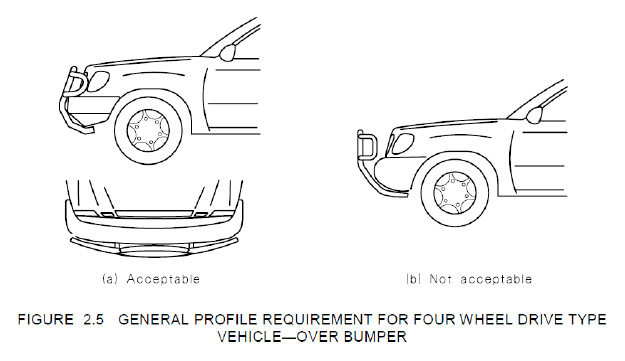

Bull bar design
Existing regulations relevant to bull bar design prohibit dangerous projections, sharp edges or corners and obstructions to lighting.
Each bull bar needs to generally conform to the shape, in plan view, front view and side view, of the front of the car to which it is fitted.
The front face of the bull bar should not lean outward from the car.
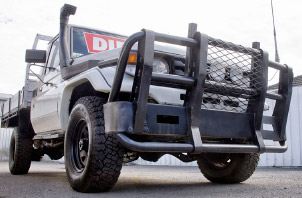
non-compliant bull bar

non-compliant bull bar
The ends of the bull bar should be curved to wrap around the profile of the car and must not protrude beyond the outer extremities (not including mirrors) of the car.
The overall height of the bar should be kept as low as possible and should not extend above the front of the bonnet line.
In all cases it is important to keep the point of initial contact (between bull bar and pedestrian) as low as possible so that a pedestrian's legs are swept upward cleanly if a crash occurs.
Unacceptable bull bars

